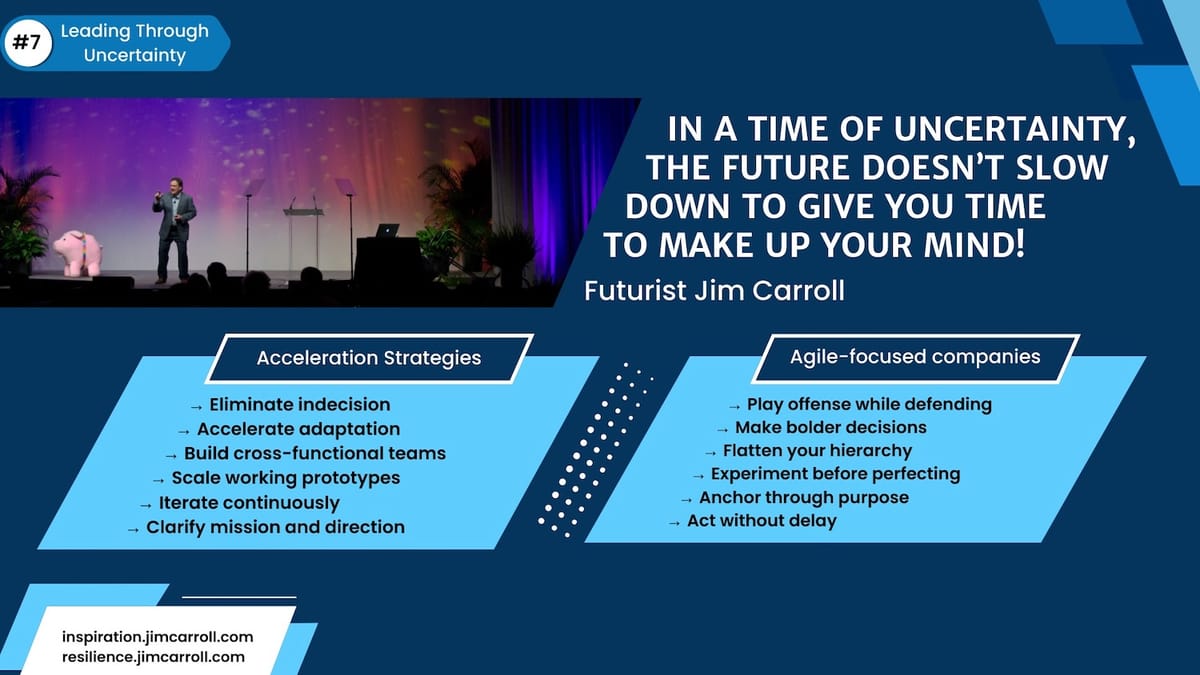"In a time of uncertainty, the future doesn’t slow down to give you time to make up your mind!"

Uncertainty is not an excuse to stall. It’s a signal to move—strategically, swiftly, and with intent.
And yet, in moments like this, indecision becomes the silent killer. Leaders delay. Organizations drift. People pause, waiting for “clarity” that never comes. And in a moment in history that features relentlessly unpredictable - and some would say insane - levels of uncertainty, indecision becomes aggressive.
But the future doesn’t reward those who hesitate. It penalizes them, punishes them, and hurts them, by setting them further back. It rewards those who know how to pivot, adapt, and accelerate—even when the ground is shifting beneath them. I've said this before: “The biggest risk isn’t moving too fast—it’s moving too slow while the world speeds up.” That reality becomes more pronounced during an era of uncertainty.
In every previous downturn, we’ve seen the same pattern. The companies that acted with agility—who streamlined decision-making, shortened timelines, and empowered their teams—came out ahead. They didn’t rush blindly. But they didn’t wait for permission, either. They were bold, fast, and focused. What did they do?
- they built cross-functional teams with the authority to decide in real-time.
- they prototyped quickly, then scaled what worked.
- they adopted an iteration mindset: test, learn, refine—then repeat.
- they aligned on mission clarity, so even in chaos, the direction was clear.
And that mindset isn’t just aspirational. It’s proven through research. I summed it up after the last crisis: “Bureaucracy is out. Speed is everything. The future belongs to those who can decide—and move.”
Here's the key thing to think about: agility isn’t recklessness. It’s responsiveness. It’s not about rushing blindly—it’s about having the confidence to move when others are still overanalyzing the map. The core idea that I've always shared in times of upheaval is action —that we must pivot, adapt, and accelerate. In today’s environment, fast beats big. The companies that win are those that can shift on a dime and execute decisively when conditions change.
The greatest risk right now? It isn’t moving too fast. It’s moving too slowly while the world speeds up. And the greatest mistake? Doing nothing.
So as this new era of global uncertainty accelerates, are you still fine-tuning your plans while others are executing theirs?
Because the future isn’t waiting.
And neither should you.
What the Smartest Companies Do in Uncertainty - Summaries from my research
Play Offense While Managing Defense
Resilient companies don’t just cut costs—they reinvest in growth while others hunker down. Agility means knowing when to shift gears, not hit the brakes.
“Playing offense almost always trumps simply hunkering down.” – Bain & Co.
Make Faster, Bolder Decisions
Speed and decisiveness aren’t luxuries anymore—they’re necessities. Companies must enable decision-making at the edge, not wait for top-down approvals.
“Faster decisions lead to better outcomes.” – McKinsey
Empower Cross-Functional Collaboration
Agile organizations flatten hierarchies and give decision rights to real-time teams. Structural agility creates momentum.
“Resilient leadership is about empowering others to act.”
Embrace Experimentation Over Perfection
The best companies try, test, learn, and adapt—quickly. They think in prototypes, not polished plans.
“Don’t wait for the perfect strategy. Build, measure, adapt.”
Stay Anchored by Purpose
Mission clarity helps teams move fast without losing their way. In times of stress, purpose is the north star.
“Core values stabilize culture when the world is unstable.”
Understand the High Cost of Waiting
Harvard research shows up to 85% of pre-recession growth leaders are toppled during downturns—often due to indecision, not miscalculation.
“Waiting too long weakens the company.” – HBR
— — —
Futurist Jim Carroll is writing a powerful series on resilience in an era of volatility and uncertainty. So far, he’s explored belief over resignation, action over fear, vision over nostalgia, innovation over inertia, and adaptability over collapse — offering a roadmap for navigating disruption and accelerating into what’s next.

